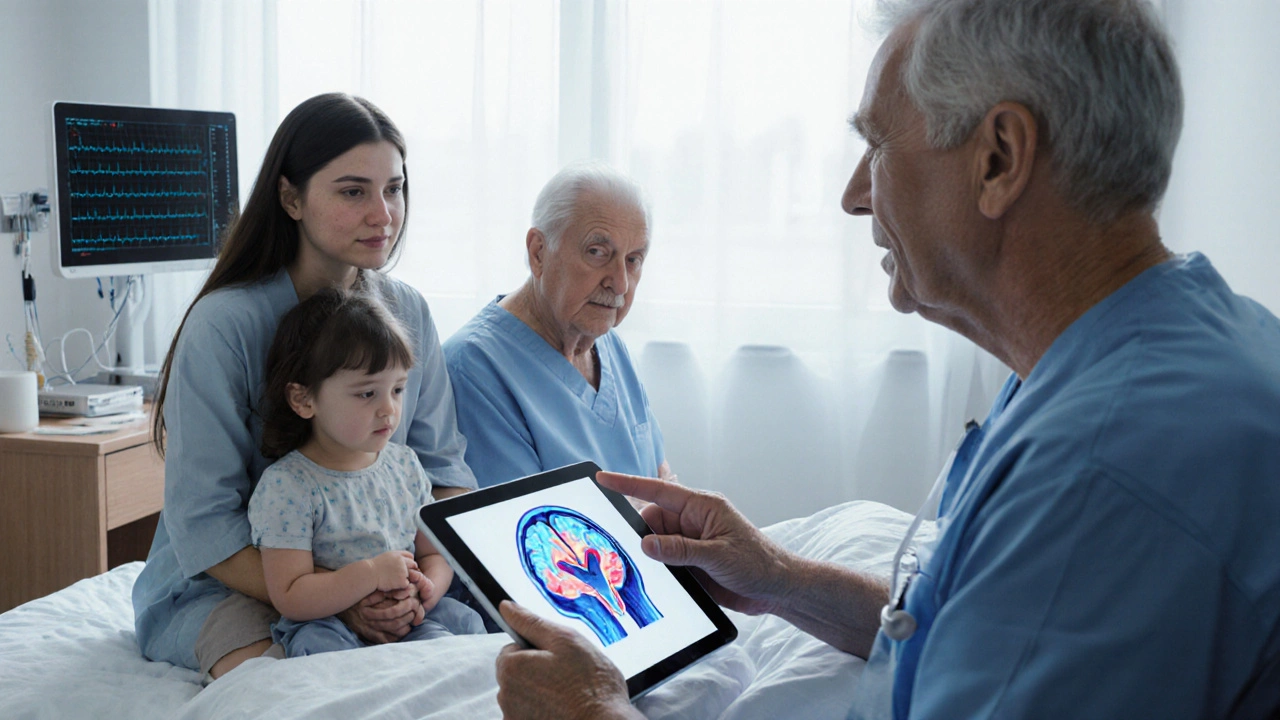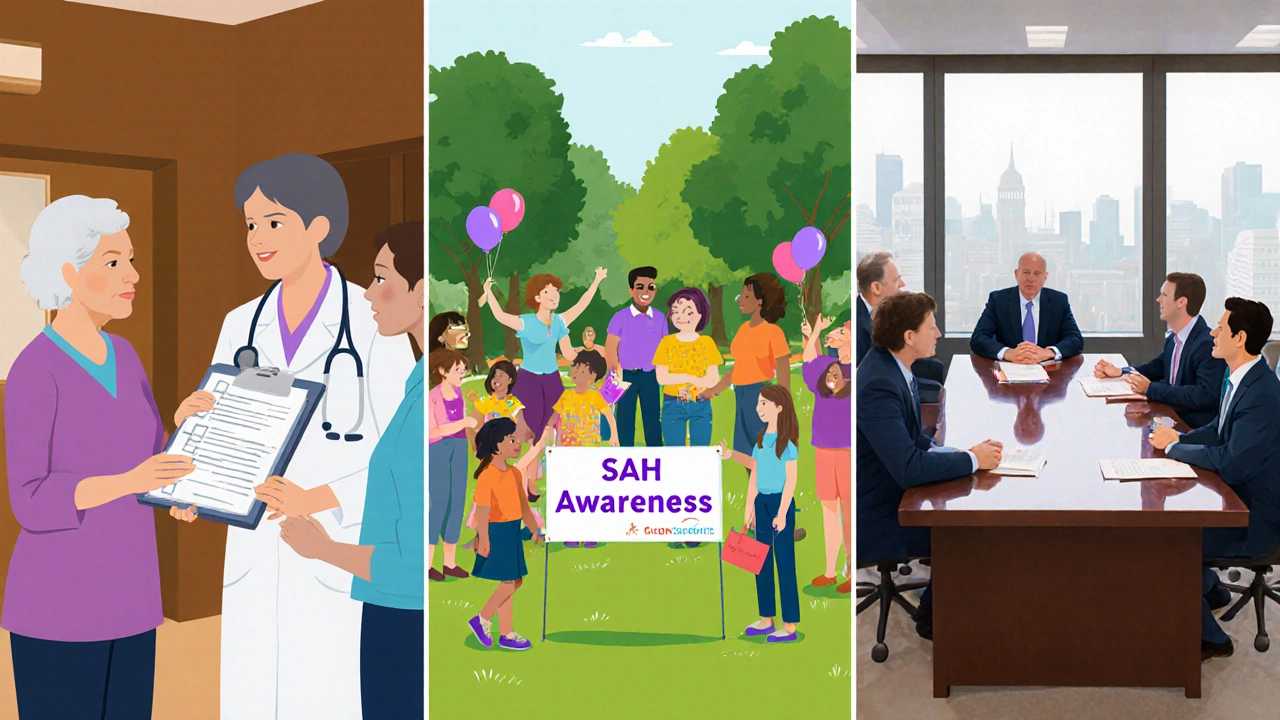Why Advocacy Matters for Subarachnoid Hemorrhage Patients & Families
 Oct, 5 2025
Oct, 5 2025
Subarachnoid Hemorrhage Advocacy Guide
Personal Advocacy
Focus on your loved one's specific medical needs and recovery plan.
- Ask detailed questions about treatment
- Join support groups
- Request personalized care plans
Community Advocacy
Raise awareness and mobilize local resources.
- Organize educational events
- Partner with hospitals
- Host fundraising activities
Policy Advocacy
Influence national healthcare standards and research funding.
- Lobby for research grants
- Submit comments on legislation
- Meet with government officials
Quick Advocacy Checklist
Need Help Finding Resources?
Get personalized guidance for support groups, financial aid, and rehabilitation options based on your location.
Want to Advocate for Change?
Learn how to submit policy recommendations and engage with local health authorities effectively.
Find Local Support
Policy Advocacy Steps
- Identify key policy issues affecting SAH care in your region
- Research current legislation or funding gaps
- Contact local representatives with evidence-based proposals
- Join or start a coalition with other advocates
- Submit formal comments during public consultations
When a loved one suffers a Subarachnoid Hemorrhage (SAH) - a sudden bleed in the space surrounding the brain - the shock spreads far beyond the hospital bedside.
Beyond the medical emergency, families scramble for answers, financial help, and emotional support. That’s where subarachnoid hemorrhage advocacy steps in: it bridges the gap between clinical care and real‑world needs.
Understanding Subarachnoid Hemorrhage
Brain Aneurysm is the most common cause of SAH, accounting for roughly 85% of cases. When an aneurysm bursts, blood rushes into the subarachnoid space, raising intracranial pressure and often causing loss of consciousness.
Key stats (2024 WHO data) show an incidence of 9 per 100,000 people worldwide, with a mortality rate near 35% if untreated. Survivors frequently face long‑term cognitive and physical challenges.
Typical treatment involves a Neurosurgeon who either clips the aneurysm or performs endovascular coiling in a specialized Stroke Unit where multidisciplinary teams monitor bleeding, control blood pressure, and manage complications.
The Ripple Effect on Families
While the patient battles the bleed, families juggle hospital visits, insurance paperwork, and the emotional toll of uncertainty. A 2023 survey of SAH caregivers in the UK revealed that 68% felt “unprepared for the recovery phase” and 54% reported increased anxiety.
Roles shift quickly - spouses may become caregivers, children might need to step into adult responsibilities, and siblings often experience guilt for not being able to help.

Why Advocacy Is Critical
Advocacy does three things:
- It amplifies patient voices so clinicians understand real‑world concerns.
- It pushes health systems to allocate resources for post‑SAH rehabilitation, mental‑health services, and community support.
- It influences policy makers to fund research, improve emergency response protocols, and reduce disparities in care access.
In practice, strong advocacy can shave weeks off the time it takes to secure a place in a specialized Rehabilitation program that addresses both physical therapy and cognitive retraining.
Types of Advocacy
Understanding the different advocacy layers helps families pick where to invest their energy.
| Level | Focus Area | Typical Activities | Key Stakeholders |
|---|---|---|---|
| Individual | Patient‑specific needs | Ask doctors targeted questions; join a support group; request personalized care plans | Patient, Family, Primary Physician |
| Community | Local resources & awareness | Organize community talks; partner with local hospitals; run fundraising events | Support Groups, Local Clinics, NGOs |
| Policy | National health policy & research funding | Submit comments on health legislation; meet with legislators; lobby for research grants | Advocacy Organizations, Government Agencies, Researchers |
How to Get Involved: Step‑by‑Step Guide
- Educate yourself. Start with reputable sources like the American Heart Association and local neurology departments. Knowing the anatomy of a Subarachnoid Hemorrhage makes conversations with clinicians clearer.
- Connect with a support group. Many hospitals host weekly meetings. Online forums (e.g., SAH‑Connect) also provide 24/7 peer advice.
- Document the journey. Keep a log of symptoms, medication changes, and appointments. This record is invaluable when speaking with a Neurologist or insurance rep.
- Request a care coordinator. Ask the hospital’s Stroke Unit to assign a nurse navigator. Coordinators streamline follow‑up appointments and rehab referrals.
- Engage emergency services. Share the patient’s SAH history with local EMS teams. Quick recognition of SAH symptoms (sudden “worst headache ever”) can cut treatment delays dramatically.
- Advocate for policy change. Write a one‑pager highlighting gaps you’ve faced and send it to your local health department. Join national coalitions that push for better SAH research funding.

Common Pitfalls & Pro Tips
Pitfall: Assuming the acute phase ends once the patient leaves the ICU.
Pro tip: Schedule a 30‑day post‑discharge check‑in with a neuro‑rehab specialist. Early cognitive therapy improves return‑to‑work rates by up to 20%.
Pitfall: Relying solely on generic online advice.
Pro tip: Verify every treatment suggestion with a qualified Neurosurgeon or neurologist. Misinformation can lead to harmful self‑medication.
Pitfall: Ignoring mental health.
Pro tip: Arrange counseling for both patient and family. Studies show that families who attend therapy report 30% lower caregiver burnout scores.
Resources & Support Networks
- American Heart Association offers a dedicated SAH fact sheet and a 24‑hour helpline
- Brain Aneurysm Foundation provides grants for rehabilitation equipment
- Local NGOs in Durban, such as NeuroCare SA which runs monthly support circles for SAH survivors
- Online community SAH‑Connect Forum where families share tips on insurance navigation
Remember, the most effective advocacy blends personal experience with factual data. By speaking up, you help shape better protocols, more compassionate care, and a brighter future for everyone touched by subarachnoid hemorrhage.
Frequently Asked Questions
What is the typical recovery timeline after a subarachnoid hemorrhage?
Recovery varies widely. Most patients spend 1‑2 weeks in intensive care, followed by 1‑3 months in a specialized stroke unit. Cognitive and physical rehab can continue for 6‑12 months, with some individuals needing lifelong support.
How can families influence hospital policies for SAH care?
Start by joining the hospital’s patient‑family advisory council. Share concrete suggestions-like adding a dedicated SAH case manager-and back them with data from reputable studies. Consistent, evidence‑based feedback often leads to policy tweaks.
Are there financial aid options for SAH rehabilitation?
Yes. Many insurance plans cover inpatient rehab, but out‑patient services may require additional funding. Check with national charities like the Brain Aneurysm Foundation for grant programs, and explore government disability benefits if the patient’s ability to work is impacted.
What warning signs should trigger emergency services?
A sudden, severe “thunderclap” headache, loss of consciousness, visual disturbances, or a stiff neck are classic SAH alarms. Call emergency services immediately; early transport to a neuro‑critical care center improves survival odds.
How can I find a local support group?
Search hospital websites for "stroke support" or contact the American Heart Association helpline. In Durban, NeuroCare SA hosts monthly meetings at the King Edward VII Hospital.
marcel lux
October 5, 2025 AT 18:28Advocacy is more than ribbon‑cutting; it’s about making sure every SAH patient gets the follow‑up they deserve. By keeping a detailed log of appointments and asking the care team specific questions, families can shave weeks off rehab wait times. Connecting with a local support group also adds a layer of shared experience that can be invaluable during recovery. When you have a dedicated care coordinator, the whole process feels less like a maze and more like a guided tour. Ultimately, the collective voice of families pushes hospitals to fine‑tune their stroke unit protocols.
Justin Channell
October 6, 2025 AT 22:46You’ve got this 🙌
Melissa Young
October 9, 2025 AT 13:16Listen, when it comes to subarachnoid hemorrhage, the stakes are sky‑high and you need to cut through the red‑tape fast. The bureaucratic slog can feel like an endless war zone, especially when insurers throw curveballs. You’ve got to champion the patient like a soldier on the front lines, no excuses. The community angle is crucial – rally local businesses and media to spotlight the urgency. Policy moves aren’t just nice‑to‑have; they’re the ammunition that funds research and lifesaving tech. So gear up, get loud, and make the system work for you, not the other way around.
SHASHIKANT YADAV
October 15, 2025 AT 06:46Advocacy feels like a gentle nudge that can become a powerful tide 🌊. Documenting every symptom and medication change helps clinicians see patterns that might otherwise be missed. Pair that data with a supportive community, and you build a safety net that catches families when they’re overwhelmed. It’s also worth noting that many hospitals now offer nurse navigators who can streamline referrals. Keep the conversation going with the rehab team; they’ll appreciate the clarity. Every little piece of info you share can tip the scales toward better outcomes.
Ryan Pitt
October 18, 2025 AT 18:06Finding a care coordinator early makes the recovery journey smoother. It’s one of the smartest moves you can make.
Jami Johnson
October 19, 2025 AT 21:53When a family steps into the daunting world of subarachnoid hemorrhage, they often find themselves at the crossroads of hope and uncertainty, a place where the medical jargon can feel like an impenetrable wall. Yet, it is precisely in this moment that the power of advocacy can illuminate the path forward, turning bewilderment into actionable steps. First, consider the act of education not merely as a passive consumption of pamphlets, but as an active, relentless quest for knowledge; read the latest guidelines from the American Heart Association, attend webinars, and absorb the newest research on endovascular coiling versus surgical clipping. This intellectual armory equips you to ask penetrating questions at bedside, such as the specific criteria for initiating a care coordinator or the timeline for cognitive therapy, which in turn forces the medical team to clarify and prioritize. Second, the family’s voice gains amplified resonance when it joins a support group, whether in person at the local stroke unit or virtually on platforms like SAH-Connect, because shared stories transform isolated fear into collective strength. Within these circles, you’ll discover practical tips-like petitioning for a dedicated SAH case manager-and emotional validation that can stave off caregiver burnout. Third, on the community front, organizing a small fundraiser or a public awareness event does more than raise dollars; it awakens local stakeholders-hospitals, NGOs, even city council members-to recognize an unmet need, prompting them to allocate resources or streamline referral pathways. Fourth, the policy arena, though often perceived as distant, is within reach when you compile a concise, evidence‑based one‑pager highlighting gaps you’ve experienced-perhaps the lack of insurance coverage for outpatient cognitive rehab-and send it to your state health department or a congressional representative. Pair this with personal narratives; policymakers respond more readily to human stories backed by data. Fifth, never underestimate the importance of mental health scaffolding; arrange for a therapist specializing in trauma or post‑ICU syndrome, and encourage every family member to attend sessions, as studies show that proactive counseling can reduce burnout scores by nearly a third. Finally, remember that every action, no matter how modest it seems, contributes to a larger mosaic that reshapes the landscape of SAH care. By speaking up, documenting diligently, connecting compassionately, and lobbying persistently, you become an indispensable catalyst for change, ensuring that future patients and families encounter a system that is not only clinically adept but also empathetically aligned with their lived realities.
Kasey Krug
October 23, 2025 AT 09:13The guide is overly long and repeats the same points without adding concrete resources.
jake cole
October 24, 2025 AT 13:00Honestly, this fluff is a waste of time; if you want real change, stop whining about checklists and start demanding action from hospital admins now.
Natalie Goldswain
October 26, 2025 AT 20:33great info but i wish it was less formal.
khajohnsak Mankit
October 28, 2025 AT 00:20Picture this: a kaleidoscope of voices, each hue representing a survivor’s story, swirling together to form a masterpiece of advocacy. Your concise note is a spark, and when that spark meets the vibrant tapestry of community effort, fireworks erupt-funds flow, policies shift, and hope blossoms. Keep painting with those bold strokes!
Pallavi G
October 30, 2025 AT 07:53I love how the checklist breaks down steps into bite‑size tasks; it makes the overwhelming process feel manageable. Also, the reminder to involve a care coordinator is crucial-often that role gets overlooked.
Rafael Lopez
October 31, 2025 AT 11:40Indeed, the checklist, with its clear headings, concise bullet points, and actionable language, serves as an excellent roadmap; additionally, emphasizing the role of a care coordinator, who can streamline appointments, facilitate communication, and ensure continuity of care, is absolutely essential for optimizing outcomes.